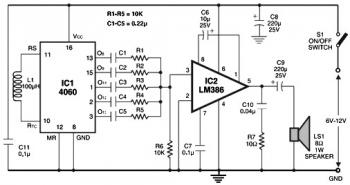Here the Multitone Alarm sound generator. This kind of multitone alarm is useful for security alarms, reverse horns, and so on. It generates five various sound tones and is also considerably more ear-catching when compared to a single-tone alarm.
The circuit is constructed close to well-known CMOS oscillator-cum-divider IC 4060 and small audio amplifier LM386. IC 4060 is utilized as the multitone generator. A 100 µH inductor is utilized at the input of IC 4060. Therefore it oscillates within the range of about 5MHz Radio frequency. IC 4060 itself separates RF signals into AF and ultrasonic ranges. Audio signals of various frequencies can be obtained from pins 1, 2, 3, 13 and 15 of IC 4060 (IC1). These kinds of multifrequency signals are mixed and given to the audio amplifier designed close to IC LM386.
The actual output of IC2 is given towards the loudspeaker through capacitor C9. If you need louder sound, work with power amplifier TBA810 or TDA1010.
Only five outputs of IC1 are being used because the other five outputs (pins 4 through 7 and also 14) generate ultrasonic signals, which aren't hearable.
Construct the circuit on a general-purpose Printed Circuit Board and enclose inside a appropriate cabinet. Regulated 6V-12V (or a battery pack) can be used to power up the circuit.
Multitone Alarm Sound Generator Circuit Source: Electronics For You
About Audio Amplifier
An audio amplifier is an electronic amplifier that amplifies low-power audio signals (signals composed primarily of frequencies between 20 - 20 000 Hz, the human range of hearing) to a level suitable for driving loudspeakers and is the final stage in a typical audio playback chain.
The preceding stages in such a chain are low power audio amplifiers which perform tasks like pre-amplification, equalization, tone control, mixing/effects, or audio sources like record players, CD players, and cassette players. Most audio amplifiers require these low-level inputs to adhere to line levels.
While the input signal to an audio amplifier may measure only a few hundred microwatts, its output may be tens, hundreds, or thousands of watts. More explanation about power audio amplifier can be found at wikipedia.org
An audio amplifier is an electronic amplifier that amplifies low-power audio signals (signals composed primarily of frequencies between 20 - 20 000 Hz, the human range of hearing) to a level suitable for driving loudspeakers and is the final stage in a typical audio playback chain.
The preceding stages in such a chain are low power audio amplifiers which perform tasks like pre-amplification, equalization, tone control, mixing/effects, or audio sources like record players, CD players, and cassette players. Most audio amplifiers require these low-level inputs to adhere to line levels.
While the input signal to an audio amplifier may measure only a few hundred microwatts, its output may be tens, hundreds, or thousands of watts. More explanation about power audio amplifier can be found at wikipedia.org
This is a video tutorial about how to a very simple audio amplifier based on the LM386 amplifier chip. It can be built for less than $20 (or might be less than $8 in some countries) and used to amplify any low level audio signal including a guitar, bass or mp3 player.
Watch the video:

No comments:
Post a Comment